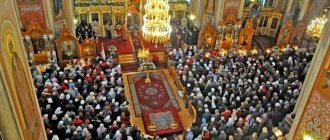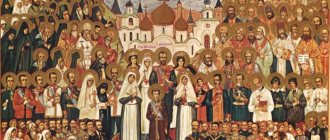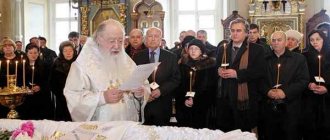Every pregnant woman has a moment when she begins to worry and worry more and more about her baby, because it is never known how the matter will end. Many people think that they need to turn to God in prayer. This will help the woman calm down, since she will be protected by higher patrons.
“And the Lord spoke to Moses, saying, Tell the children of Israel, If a woman conceives and gives birth to a male child, she will be unclean for seven days; as in the days of her suffering by purification, she will be unclean; on the eighth day his foreskin will be circumcised; and she must sit for thirty-three days, cleansing herself from her blood...If she gives birth to a female child, then during her cleansing she will be unclean for two weeks, and sixty-six days she must sit, cleansing herself from her blood....
After childbirth, a woman can visit the temple only after 40 days
Uncleanness according to the Old Testament indicates whether an Orthodox person can take part in any church rituals. Ritual purity is something incomprehensible to the human mind, but for the church it is not so important. One law that still exists today is nida.
Nida is female impurity. After the birth of a child, a woman cannot avoid bleeding. Nida occurs until the eighth clean day, when the discharge has already stopped.
A pregnant woman after giving birth cannot visit the temple. And it can be no earlier than 40 days. If a woman wants to visit the temple before the baptism of her child, then she needs to perform a ritual ceremony. The ceremony is performed by a priest.
If a woman wants to visit the temple before the baptism of her child, then she needs to perform a ritual ceremony. The ritual is performed by a priest
Impurity in Christianity
With the coming of the Savior to earth, much in the doctrine of God changed. With his activities, he violated the norms of the Old Testament teaching, which aroused hostility on the part of the Jews. The Son of God neglected all the commandments of ritual purity - he freely touched everything and everyone that could cause desecration, easily communicated with sinners and pagans, and did not even observe fasts.
One of the most striking examples of such neglect is the touching of the Savior’s clothes by a woman suffering from bleeding. At the same time, Christ not only did not reject her as unclean and defiled him with her touch, but even encouraged her, saying that through her faith, sins are forgiven and healing is granted. For the Lord, nothing was unclean and nothing could defile him, including female uncleanness.
Along with the Teacher, his disciples also did not comply with the demands of their fathers. To the natural indignation of the strict followers of the law, Christ replied that the sons of the bridal chamber (i.e., the disciples), having the bridegroom (Christ) with them, may not fast, but when he is taken away from them, then the time will come to grieve and follow paternal instructions.
The violation of Old Testament laws by Christ's disciples is understandable, but what is the situation with this today? Is it possible for a woman after childbirth to attend services and participate in the sacraments before the end of the prescribed 40 days without performing a cleansing prayer, and is it necessary at all? Indeed, according to the teachings of Christ, for God only evil and sinful thoughts emanating from the human heart are unclean and defile a person.
The concept of female impurity in modern Orthodoxy is a controversial issue. Most clergy are inclined to believe that it is possible to lead an active church life and even participate in church sacraments, in particular the Eucharist, or communion of Christ’s bloodless sacrifice.
In pre-Christian times, divine services were necessarily accompanied by bloody animal sacrifices. With the coming, death and resurrection of the Savior, Christians “agreed” that the last bloody sacrifice offered to God as atonement for the sins of all mankind was Christ and that in the history of mankind there should be no more pleasing the Creator with the help of blood. At the same time, Christ gave such authority to his disciples, telling them that what you permit and establish on Earth will be permitted in Heaven.
Read also:
After the birth of the child, I completely stopped loving my husband
From here the requirement for the absence of any blood in the Temple becomes clear.
According to priests who allow the participation of “unclean” women in church life, with the advent of modern hygiene products, a woman cannot desecrate the House of God with her blood and nothing prevents her spiritual aspiration and communion with God, who is “impartial” (does not divide people into bad and good) and is the Creator of all things, including women with “uncleanness”.
Confirmation of this can be found in the decrees of the Didascalia - early Christian texts whose authorship is attributed to the Holy Apostles. (Ordinances of the Holy Apostles. Didaskalia. Book 6, ch. 27-30). In particular, it says that the birth of children is pure, and no natural secretions of the human body are an abomination to God. The Holy Spirit is present in a person in any physical condition, and defilement is not at all what is prescribed in the Old Testament law. And there is a call to adorn oneself with holiness, participating in the life and sacraments of the church, not paying attention to bleeding or any other regulations of ritual impurity that limit such participation.
The main prohibition for visiting the temple is that a woman should not shed blood.
But it is worth mentioning not only about religious issues regarding the ban on visiting a church for a young mother and her child. This, for example, is the fact that many people can get sick, even with simple colds, and this can greatly affect the child’s health.
What other prohibitions should you know about visiting a temple? It is also important that in the church a woman should not shed blood - this is a great law. Therefore, nowadays there are many hygiene products that women can use.
To go to temple after childbirth, there is a special prayer. The prayer should be read before the priest. If you follow the laws of the Bible, then this happens on the fortieth day after birth. In order to get to your child’s baptism, you need to read the 40th day prayer.
How to quickly stop lactation?
The speed of cessation of lactation depends on a number of factors:
- The baby's age and the amount of milk produced.
- Stage of pregnancy when it is terminated (lactation is possible after termination of pregnancy after the 18th week).
- The amount of milk expressed, milk flowing out.
- Pressure on the nipples (during work, sports, sex).
- Presence of next pregnancy.
Some mothers take weeks to stop breastfeeding. For others, the process takes only a few days. However, milk stains on your bra can sometimes be noticed several months or even years after you think that lactation has stopped: for each mother, the process of stopping lactation occurs individually.
After childbirth, a prayer is read - permissive
Prayer after childbirth is permissive. It is this cleansing prayer that gives permission to visit the Church.
Permissive prayer:
From them, and upon us, we receive each other (successively, one after another) by the grace that has come, so that through me, the humble one, this child (name) may be forgiven in spirit from all, even if, as a man, he has sinned against God in word, deed, or thought, and with all your feelings, willingly or unwillingly, knowledge or ignorance.
If you were under an oath or excommunication by a bishop or a priest, or if you swore an oath to your father or mother, or fell under your own curse, or broke an oath, or committed some other sin (here: was forbidden, was subject to a curse), but repent of all these with a contrite heart and from all those guilts and burdens (from what binds) let him (you) be released; great for the weakness (and everything that is due to weakness) of nature was given over to oblivion, and may she forgive him (her) everything, for her love for mankind, through the prayers of our Most Holy and Most Blessed Lady Theotokos and Ever-Virgin Mary, the glorious and all-praised apostle saints and all the saints. Amen.
When is the prayer of permission read?
God, through the priest, forgives human sins through a “formula” of cleansing. This “formula” is the prayer of permission. It should be pronounced only in those cases when a Christian believer really realized his committed sins and mistakes and hated them. Only in this case can a person not repent if this prayer is read during the funeral service. So when is the prayer of permission read?
In the Orthodox Church there are only three cases when forgiveness of sins occurs using the prayer of absolution:
- during the funeral service;
- after childbirth;
- after confession.
A cleansing prayer is read after the end of bleeding
There is also a cleansing prayer. A young mother should read it before visiting the temple of God, but only after the bleeding has stopped.
This is a prayer to the Most Holy Theotokos, which is read for three days three times a day. You can read the prayer after the birth of the baby.
A cleansing prayer is read to the Mother of God
Purifying Prayer of the Mother of God:
When can you start praying?
Impurity in the Old Testament speaks to whether an Orthodox person can take part in church rituals. The commandment about ritual purity is not comprehensible to reason and is accepted as it is. These commandments do not need to be specified or rationally explained, nor do they need to look for prerequisites. This is what distinguishes the commandments of “purity” from the commandments that people can explain to their minds.
In the modern world, ritual purity is not so important for the church and people in general. For various reasons, these laws simply ceased to be enforced. The only law that exists in the real church is nida. Although it is slightly modified, it is still part of Christian customs.
What is Nida?
Bloody discharge after pregnancy is an inevitable factor. They occur with bleeding in the form of lochia, discharge after childbirth. This term also includes regular menstruation.
Nida is female impurity when it has bloody discharge.
But this does not mean that a woman tolerates hostility, negative comments or emotions, or squeamish attitudes from other Christians. Society still treats the mother as a sacred object, protects and loves her.
Nida lasts until the eighth clean day, when the discharge has stopped. Usually the ritual says that you need to take a cleansing bath in a specially equipped ritual pool.
Bloody discharge, as is believed in the holy scriptures, is a woman’s self-cleansing of sexual contacts and the dirt that they brought into her life.
Nida gives rise to the following prohibitions for visiting the temple:
- As stated above, these secretions are considered “uncleanliness”.
- Due to the lack of hygiene products in the old days, there was a ban on entering the temple, since shedding blood in the church was a great sin.
- The temple is a gathering place for a huge number of people. A mother with a newborn baby can get very stressed from a lot of people. Therefore, it is not advisable to take your baby with you to church in the first three to four months, and also to pay attention to colds and related epidemics.
The modern world allows “unclean” women into church life. This is due to the presence of hygiene products that help a woman not shed blood. The house of God cannot be desecrated by a woman’s blood, which means that a girl can calmly strive spiritually for God, who does not divide people into two categories: good and bad. The Creator of existence accepts everything, even women’s “impurity.”
It is also worth remembering that during female uncleanness it is prohibited:
- Sexual intercourse with husband.
- Touches.
- Embrace.
- Kisses.
- Eating at one table.
- Shared bed.
Prayers of thanks can be read after the end of bleeding. They can be read three times a day for three days.
Before a caesarean section, you can also turn to God and the saints in prayer
Also in medical practice there is such a word as caesarean section. How does it go? And what is this? A caesarean section is an operation in which the baby is delivered through an incision in the uterus. Sometimes it happens that the expectant mother cannot give birth herself due to the physiological structure of the body. In such cases, a caesarean section is performed.
Many women also go through this process. Prayers should also be read for a successful delivery. How will such a prayer help? This prayer will help:
- gain peace of mind;
- the surgical intervention will take place without any complications;
- the child will be born healthy.
A woman in labor needs to start reading prayers 2-3 months before surgery
Prayer to Matrona of Moscow - will help to undergo surgery
A prayer to Matrona of Moscow will help you endure surgery with ease, and will also help you heal faster.
A prayer to Matrona of Moscow will help you endure surgery with ease, and will also help you heal faster
Prayer to Matrona of Moscow:
Matrona, your soul is far away, guarding the Golden Throne of the Lord, but the ashes remain on the ground. Hear my appeal, allow slave (name) to find peace and ask God to provide me with his protection. Let me give birth to a healthy baby, don’t make him pay for my sins, which I sincerely repent of every day and night. I trust only in You and believe that Your mercy will be limitless. Amen.
By leaving a comment, you accept the user agreement
Prayer of a woman in labor before a caesarean section - read 2-3 months before giving birth
Who should I pray to? You can pray not only to the Supreme Patron, but also to the Saints, for example, Matrona of Moscow, Healer Panteleimon.
But it is important to understand that your prayer must come from the heart. It is better to forget about sadness and completely surrender to thoughts about the birth of the baby. A mother's prayer may be offered when she gives birth to her daughter.
When a daughter gives birth, her mother can pray for her
Prayer of a woman in labor before a caesarean section:
Be prepared for leaks!
Even after the cessation of lactation or in its last stages, unexpected copious discharge of milk from the breast is possible. This can happen when hugging a partner, when having sex with him, when being sexually aroused, when thinking about a child, when touching the breast. To prevent unexpected milk leaks, wear absorbent pads in your bra. Keep a spare supply of such gaskets with you. Wear dark-colored tops so that milk stains are not as noticeable. Take a spare set of clothes with you, especially for more important occasions.
Express some milk before leaving the house. If you feel milk leaking, cross your arms over your chest to stop the flow.
In all cases, get advice from a breastfeeding specialist on how best to stop lactation in your case.
Uncleanness - what is it and where did the concept come from?
The concept of uncleanness comes from the biblical Old Testament. Purity or impurity determines the state of a person, allowing him to take or not take part in the temple cult. In essence, this is ritual purity.
In complex Jewish law, ritual purity goes hand in hand with the idea of holiness. The laws set forth in the books of Moses covered all aspects of life, which reliably prevented the penetration of pagan culture into religion and reflected the ancient idea of the Jews about the close connection between God, man and the Universe.
Unlike the commandments, which are classified as explainable from the point of view of the human mind, the commandments about ritual purity are classified as incomprehensible to reason and accepted a priori, that is, perceived as a law unconditionally and without a rational explanation of its premises.
Many consider these laws as hygienic rules, but the Bible clearly defines that they have a sacred meaning, not a material one. (eg Lev. 11:43-44)
According to Jewish laws, any person without exception could become defiled by uncleanness. Both old and young, and even a newborn one day old could be defiled by all its varieties.
The highest degree of uncleanness is cadaveric, and anyone who was in the same room with the deceased, touched him or the grave, was considered ritually unclean after that for 7 days and was not allowed to enter the Temple. Interestingly, uncleanness extended not only to people, but also to the water in open vessels located next to the corpse. It was possible to eliminate the state of impurity after the prescribed period had passed through special cleansing rites, often with sacrifice.
About the uncleanness of people in the church
Human “dirt” in Christianity is called uncleanness - we are not talking about physical or even spiritual dirt. Uncleanness is a state of a person that does not allow him to take part in church ritual ceremonies. This is a law that is determined at the sacred level, so it should not be associated with hygiene procedures. A person becomes defiled by uncleanness on certain occasions. For example, a person becomes defiled by uncleanness if he has been in the same room with the deceased for some time.
Here we can also highlight the simple feeling of the deceased - in this case, for a week it is forbidden not only to take part in ritual ceremonies, but also to enter the temple. People who have visited the grave or touched the grave soil or slab are prohibited - this is the law. The water, which can often be found under the deceased in the coffin, can be polluted by uncleanness - during the funeral service for the deceased, the vessel was not brought into the temple.
This is interesting: Getting rid of uncleanliness is difficult, but it is possible. True, for this you will have to go through a certain ritual, even with a sacrifice. It may not be necessary to make a sacrifice today in the form of killing an animal, but this should not be ruled out.
Nida, or female impurity in the Old Testament
Currently, almost all of the Old Testament laws of ritual purity have ceased to be observed for various reasons. An exception is the law of nida, which also entered the custom of Orthodox Christians in a slightly modified state.
Nida is a ritual state of female impurity during bleeding associated with menstruation, discharge after childbirth and any other reasons that cause spotting. The state of uncleanness for the above reasons does not imply any hostility, disgust or other negative emotional manifestations towards a woman.
This state lasts until the countdown of seven “clean” days after the cessation of discharge and the performance of a cleansing ritual by washing in a mikvah - a ritual pool equipped according to special rules. During the period of uncleanness, a woman is prohibited from having sexual intercourse with her husband, as well as other manifestations of bodily intimacy - touching, hugging, kissing, sleeping in a shared bed, eating at the same table, and others.
About the uncleanness of a pregnant woman or young mother
A woman is defiled by uncleanness during the period of bloody discharge from the vagina - this can occur during menstruation or after childbirth. In the Old Testament there are a huge number of laws for conducting various ritual ceremonies regarding women during the period of bloody discharge and the time of uncleanness. Today, in Orthodox churches only the nida ritual is performed, which also undergoes noticeable changes in getting rid of impurity.
Video
Nida is a ritual rite that begins on the seventh “clean” day (after the complete cessation of bleeding). Next, before visiting the temple, a special ritual is performed - the woman is washed in the mikveh. A mikveh is a special font built according to the laws of the Bible. The ritual ceremony is performed by the priest of the church. In the future, the woman can visit the temple until the next bleeding.
This is interesting: A correctly performed nida ritual means a complete absence of sexual contact with a man. God forbids touching, hugging, kissing. A woman should even sleep in a separate bed from her husband - this is followed for a clean week. Otherwise, she does not get rid of impurity.
Mother's prayers
Let's go back to our times. According to the existing tradition, a cleansing prayer is performed over the mother after a 40-day period after childbirth, timed to coincide with the end of the bleeding and baptism of the newborn. Do not confuse it with the permissive prayer (the permissive prayer is read after confession and at the end of the funeral service for the remission of sins).
Permissive prayer after childbirth (text)
Our Lord Jesus Christ, by His Divine grace, the gift and power given by His holy disciple and apostle, to bind and solve the sins of men, said to them: receive the Holy Spirit; Their sins, if you forgive them, will be forgiven them; hold them, they will hold; and even if you bind and loose on earth, they will be bound and loose in Heaven. From them, and upon us, we receive each other (successively, one after another) by the grace that has come, so that through me, the humble one, this child (name) may be forgiven in spirit from all, even if, as a man, he has sinned against God in word, deed, or thought, and with all your feelings, willingly or unwillingly, knowledge or ignorance. If you were under an oath or excommunication by a bishop or a priest, or if you swore an oath to your father or mother, or fell under your own curse, or broke an oath, or committed some other sin (here: was forbidden, was subject to a curse), but repent of all these with a contrite heart and from all those guilts and burdens (from what binds) let him (you) be released; great for the weakness (and everything that is due to weakness) of nature was given over to oblivion, and may she forgive him (her) everything, for her love for mankind, through the prayers of our Most Holy and Most Blessed Lady Theotokos and Ever-Virgin Mary, the glorious and all-praised apostle saints and all the saints. Amen.
Safe first encounter with a newborn
A new question arises: when can you show your newborn to family and friends? At first glance, the answer is simple: after 40 days. On the one hand, this is true, on the other hand, you need to take all the necessary measures for the comfortable conduct of the first screenings:
- No more than 10–15 people should be invited to the first viewing of a newborn. It is better if these are relatives and close friends;
- Organize the whole process correctly, choose a room or place in nature. If you invite guests to your home, try to think in advance about the placement of guests, and also create a quiet corner for mother and newborn;
- Try to ask those invited in advance not to come if you have any ailments. Despite the 40-day stage, the child is still weak and any virus can negatively affect his health;
- For mother and newborn, it will be difficult to go out to meet each guest; it is better if all the invitees gather in one room, and mother and child come out to them for a few minutes;
- After all the guests have left, pay more attention to the newborn: prepare him a bath with herbs (Read the article, herbs for bathing a newborn >>>), give him a soothing massage, feed him and put him to bed. The child must understand that it was an ordinary day and he is not in danger. Therefore, let your loved ones take care of cleaning and seeing off guests.
Very often, invited guests ask to suggest what they can give to a newborn for his first holiday. Therefore, try to plan in advance who will give what.
The safest option is size 2 and 3 diapers. Do not order 1 as your child is growing quickly and there is a chance they will become too small for him quickly.
Prayer after childbirth (text)
Virgin Mary, rejoice. Blessed Mary, the Lord is with you; Blessed are You among women and blessed is the fruit of Your womb, for You have given birth to all our souls as the Savior.
Mother of the Most Holy Theotokos, Virgin Beautiful Mary, I ask You, Thy servant (name). Just as You gave birth to Your son, Jesus Christ, so regenerate me, the servant of God (name), restore my blood, and veins, and joints, and my bones. So that, just as the cartilage of a small child is restored, so the face of God’s servant (name) is restored and reborn with my birth. Amen! Read 3 times for 3 days in a row.
If a woman wants to express special reverence and humility before God, thereby confirming that she wants to fulfill all the Divine Commandments, even those not subject to human reason (and female uncleanliness is just one of their kind), then performing this rite is commendable and is necessary before the baptism of a child or communion notify the priest of your desire. But failure to comply with this tradition does not place a woman on a par with inveterate sinners and does not hinder her path to salvation and life in Christ. Immediately after childbirth and at any time, a prayer of thanksgiving to the mother is appropriate.
Do not torment yourself with thoughts about your uncleanness after childbirth. This concept is beyond understanding, and trying to somehow logically explain it, we will drive ourselves into a dead end, which will not bring anything good to our faith.
Trust the decision of your spiritual father or clergyman. If he does not attach importance to cleansing prayer, then he is right. If he demands its completion, then he is also right. Do not philosophize, thereby giving food to your pride. And don't try to follow every letter of the Old Testament laws. Remember - where there is law, there is no grace.
Prayer of permission at the funeral service
Everyone who considers himself a Christian must fulfill his religious duty and carry out his loved ones on their last journey with dignity. The church prays for the forgiveness of the sins of the dead not only at funeral services and memorial services. When a person is sent to eternity, the clergyman performs the funeral ceremony, then burial occurs.
At the end of the funeral service, the priest reads a prayer of permission. Its text is written on a sheet, which must be included in any funeral set. After the prayer is read, it must be placed in the deceased’s right hand.
The text of such a prayer contains requests from all those praying and on behalf of the priest for forgiveness of the deceased’s sins. This expresses the hope that the Lord will free and forgive a person from earthly sins and accept the deceased into heaven. In addition, the prayer asks to deliver the deceased from various curses that could have been imposed on him by ill-wishers in life.
Thus, during the funeral rite, the prayer of permission is a very important component. Priests call this prayer the main thing for those who have passed on to another world. In the church, the prayer of permission is also called “the wayside prayer.”
Until when, when baptizing a child, should the mother read a prayer on the fortieth day?
The priest reads a prayer to the mothers of the children after forty days. They come to baptize babies who are already forty days old. So the question is: up to what age is a mother’s prayer read?
The prayers read to the mother on the 40th day after the birth of the child are a church blessing for her to participate in the Sacraments (primarily Communion) and to return to a full-blooded church life, in which she did not participate during the period of birth.
It would be wrong to begin the Sacraments without such a blessing, so it would be better if a mother, over whom no prayers were read for 40 days after giving birth, asks the priest about this, even if quite a significant period has passed since the birth of the child.
Today there is no other official position on the issue of reading a cleansing prayer over the mother, other than the generally accepted practice before the revolution and in the Soviet era.
Archpriest Sergius Bulgakov, in his Handbook for clergy, points out: “The ritual of the fortieth day contains the mother’s cleansing prayers. The essence of these prayers is to bring the postpartum woman, who has been excommunicated from the temple for the period of purification, back into the temple after a period of forty days, which is why this ritual must be performed in the temple itself. In addition, the ritual of the fortieth day includes prayers for the baby brought by the mother, who, judging by the instructions at the beginning of the 3rd chapter of the Trebnik, has not yet been baptized.”
Based on what has been said, the prayer of a mother present at the baptism of her child, even if not for 40 days, should not be omitted, since the priest prays not only for the purification of the mother, but also asks God to grant her Holy Communion. In addition, the prayer must be read before the Sacrament of Baptism itself, so that the mother has the opportunity to prayerfully participate in the baptism of her child.
Orthodox Life
Priest Andrei Chizhenko answers.
In church liturgical practice, such a ritual was called “Prayers to the woman in labor (who gave birth - author’s note), for forty days,” that is, after forty days after childbirth. This ritual also includes prayers for the blessing of the child in labor and churching (introducing or bringing the youth or baby into the temple).
Indeed, this rite is not a Sacrament. But let us remember the words of the Savior spoken by Him before Saint John the Baptist was to baptize Him: “...leave it now, for thus it is fitting for us to fulfill all righteousness” (Matthew 3:15). That is, although the Son of God should not have fulfilled all the commands of God the Father given to the Old Testament Church.
Doesn't this mean that we, Orthodox Christians, should fulfill all Divine truth given to the New Testament Church? Of course, we must follow the example of our Lord Jesus Christ, because all the Sacraments and rituals of the Orthodox Church are a stairway to Heaven. They are intended for our salvation.
Here it is necessary to say, with God’s help, that the Church, as a loving Mother, strives to sanctify with the grace of the Holy Spirit all stages of a person’s life, starting from birth and never ending. If we look carefully at what today can be called the Sacrament of Baptism, we get a kind of combined fusion of two Sacraments - Baptism and Confirmation and several rituals (naming, prayers of the catechumens, anointing with oil, washing, cutting hair, often the prayers of the mother and the so-called churching ). Now, for convenience, this is all combined into a single alloy, lasting about one hour. But this was not the case in the ancient Church... There was a whole period of gradual immersion into the wondrous world of faith, into the Church, if you like, of the child, his family, successors and relatives. Their entry into spiritual Heaven on earth - into the Church of God. In fact, it was and remains a never-ending pilgrimage-journey to God - a stairway to Heaven. I really like the apt and figurative expression of Hegumen Nektary (Morozov): “Churching is, as it were, a person’s growing into the body of the Church, the transformation from a nominal Christian into a real Christian, entering her life so deeply that this life becomes fully his life." This expression shows us that both baptism and churching are not just a formality, not just words and some kind of stamp. No. This is a living process of connecting each individual person with the Church of Christ and with God Himself, as far as this is generally possible for a person. This is the real road to heaven, to salvation for each of us. And we just need to try to follow it with God’s help!
So, let's return to the ancient Church. On the very first day, when the wife gave birth to a child, a priest was called to her, who blessed her and the child and read certain prayers. In them, he prayed for the healing of the woman in labor, for the forgiveness of her sins, for protection from evil spirits and illnesses of the baby. Later, in Soviet times, of course, this ritual practically fell out of use, since priests were simply not allowed into the maternity hospital. But the prayers (let’s call them the prayers of the first day) can be read now. Even today, it is possible to negotiate with the doctors and the priest so that he can be allowed into the maternity hospital, into the ward, to read these prayers over the mother and child. Many priests read these prayers for their mothers and newborn children.
On the eighth day (biblical Old Testament tradition; the Infant Jesus was named on the eighth day (Luke 2:21)) the baby was brought to the temple, and the priest named him. In the missal there is a “Prayer for the sign of a boy who receives a name on his eighth birthday.”
Further, if we carefully read the rites of the breviary, we will see that the creation of the catechumen, anointing with oil, the Sacrament of Baptism, and the Sacrament of Confirmation almost everywhere have an initial priestly exclamation and dismissals. This indicates that all these rites were split up and performed one after another at different times. For example, washing and cutting of hair took place on the eighth day after the Sacrament of Baptism. This action was due to the fact that baptisms in the ancient Church very often took place before Easter. And throughout Bright Week, the newly enlightened person (a person who had just been baptized) had to attend all the Easter services of the daily cycle. During them (or immediately after them) mystagogies took place in churches - esoteric sermons that prepared believers for participation in the life of the Church, and especially in the Sacrament of the Eucharist. Mystagogy was carried out necessarily after the Sacrament of Baptism had been performed on a person, since it was believed that only the grace of the Holy Spirit, given to the newly enlightened person in the Sacrament of Baptism, opens his mind, heart and soul to understand and enter into the Sacrament of Communion.
The eighth day also had its own symbolism. For six days the Lord created the world; on the seventh day He rested from His labors. And the eighth day is a new era. The time of the Second Coming of Christ, the time of the new world, the new mountain city of Jerusalem. Therefore, bringing the newly enlightened person to the temple (often at the end of Bright Week, on Antipascha (from baptisms, which often took place on Holy Saturday, just on the eighth day)) to be washed and tonsured symbolized the fact that, having been baptized, he enters eternity, into a new world, into the spiritual Heaven.
Now all these Sacraments and rituals are connected, as a rule, with each other into a single whole. But we, of course, should not lose their spiritual meaning.
As for churching. It takes place on the fortieth day after birth. It can be later. The tradition of the fortieth day is also biblical. It was on the fortieth day that the Most Holy Theotokos and righteous Joseph the Betrothed brought the Divine Infant Christ to the Jerusalem Temple, as prescribed by the law of Moses. Therefore, we, following the example of the Savior and the Holy Family, perform the ritual of churching precisely on the fortieth day. Allowed later, but not earlier. Biologically, this is connected with the cleansing of the mother’s womb after childbirth: the release of the placenta, water, blood, etc. Liturgically: after undergoing the rite of churching, a woman is allowed to partake of the Body and Blood of Christ. Before this, in principle, she cannot receive communion. Only due to fear of death (serious illness or threat of death) is a woman allowed to receive communion without going to church. Another feature: if the mother is not a believer or has already died, then the ritual of churching can only be performed with the child. This excludes the mother's prayers. Churching of a person is carried out only once in a lifetime. For the mother, it is clear that a repetition is possible if she gives birth to children during her life.
The ritual of churching itself can be divided into two parts. In the first, before the ceremony, the mother and child are placed in the vestibule of the temple, where a priest in a phelonion and with a cross comes out to them.
Structurally, this part consists of the usual beginning “Blessed is our God according to the Lord’s Prayer.” After several prayers, the priest reads prayers for the mother and the child. It is noteworthy that in the explanations to the ritual it is written that at a certain moment the mother must bow her head with the baby “together”, that is, from Church Slavonic - “together”, touching her head to the child’s head. This means that now the life of the mother and child seems to be connected into a single whole, into a single life, in fact, like the life of their entire family.
During this veneration, the priest places the sign of the cross on the child’s head. Prayers over the mother are predominantly purifying and permissive in nature. The priest asks that the Lord cleanse the woman in labor from filth and sin and grant her communion of the Holy Mysteries of Christ. Prayers over a child are mostly blessing. An example from the rite of churching: “And the child born of her, bless, grow, sanctify, give understanding, chastity, good wisdom...”.
I quote the second part of the rite from the Clergyman’s Handbook:
“...The priest, taking the child in his arms in the vestibule of the temple, makes the sign of the cross for them before entering the temple and proclaims:
‟The servant of God (servant of God, named) is churched in the Name of the Father and the Son and the Holy Spirit. Amen".
The newly baptized person enters the Church, and through it into the New Life, into the Kingdom of God.
Having brought him into the temple, the priest says:
“He will enter Your House and bow to Your Holy Temple.”
Upon entering the temple, the newly baptized person is immersed in the spiritual element of unceasing joy, peace, love and praise. Stopping in the middle of the temple, the priest exclaims: “The servant of God (name) is going to church!” In the midst of the Church he will sing to Thee.”
Approaching the Holy of Holies - the altar, the priest, holding the baby facing him, again says:
“The servant of God (name) is becoming churched.”
Here, at the Throne of the Most High, his whole life should be fulfilled.
Next, the male child is brought into the altar through the northern door and carried around the throne through the High Place. The child is offered to God and worships Him. (In no case should a baby be placed at the altar or altar, as is done in some parishes.) At the same time, the priest recites the song of Simeon the God-Receiver:
“Now you are releasing Your servant (Your servant), O Master, according to Your word in peace: for my eyes have seen Your salvation...”
Churching ends with the usual dismissal, after which there is a kissing of the Cross. This final rite can be correlated with the “baptismal procession” in the ancient Church, adapted to the circumstances of the Baptism of an infant, during which the newly baptized with lighted candles walked from the baptistery to the temple to participate together with the entire community in the Sacrament of the Eucharist.”
It is noteworthy that in the breviary it is written: before the dismissal of the church, the priest “lays it (that is, the baby. - Author's note) at the door of the altar (the Royal Doors - Author's note). And so the receiver, having bowed three times, takes off and departs.”
It is interesting about this written in the above-mentioned Handbook of the clergy: “The instruction of the Breviary “And no one places him (the baby) at the door of the altar...” should not be taken literally, since in the Greek original in this place there is the word “tifisi”, which can be translated and how it “supplies”. Moreover, to place a newly baptized and anointed baby on the floor would mean to humiliate these two great Sacraments. He should be handed over to the arms of his mother, who by that time was already standing at the Royal Doors.”
Another liturgical subtlety. It is necessary, with God's help, to answer the question: why is the rite of churching in the breviary before baptism? Liturgical scholars answer this question as follows.
It is quite possible that the first part of the rite, which we mentioned above, was actually performed on the mother and child before the Sacrament of Baptism, and the second part - after the Sacrament of Baptism. Initially, the first and second parts were independent rites, separate from each other, which later merged into one. And now, in most cases, this united churching takes place after the Sacrament of Baptism.
And we, dear brothers and sisters, will rejoice that the Mother Church so fully and deeply accepts us into Her arms, uniting us with Christ. Let us try to treat the Orthodox Sacraments and rituals not just as a tribute to a good grandfather’s tradition, but as stages and sources of saving life in Christ.
For they are the channels through which we receive the grace of God, which life-giving and resurrects us.
Priest Andrey Chizhenko











